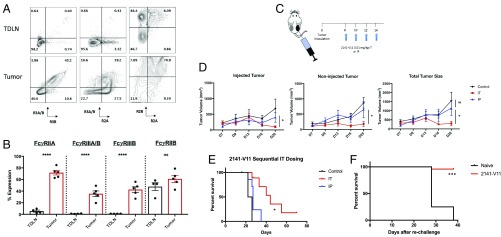Fig. 3.
Fc receptors are up-regulated in the tumor microenvironment. (A) Humanized CD40/FcR mice were implanted with MC38 tumor cells and allowed to engraft for 2 wk. Tumors and the TDLNs were then harvested and dissociated for analysis of infiltrating hematopoietic cells expressing different human Fc receptors. Cells were gated to exclude doublets followed by gating on live murine hematopoietic cells (live/dead aqua negative/mCD45+). Fc receptors were then evaluated on all infiltrating leukocytes. (B) Quantification of the different Fc receptors expressed on infiltrating leukocytes within either the TDLN or tumor (n = 5). Compared with the TDLN, there are significantly higher levels of all activating receptors (FcyRIIA and FcyRIIIA/B), whereas the TDLN also expresses high levels of the inhibitory receptor FcyRIIB. Data are displayed as the mean ± SEM. ****P < 0.001; ns, nonsignificant. (C) Schematic overview of bilateral tumor model and injection schedule. (D) MC38 tumors were s.c. injected and allowed to engraft into the bilateral flanks of mice until palpable. Mice were then treated at one-tenth the MTD of 2141-V11 (0.01 mg/kg) given either intratumorally or intraperitoneally on days 8, 10, 12, and 14. Tumor volumes were measured via caliper every 3–4 d (n = 5–8 mice per group). For i.p. dosing, the right tumor was measured as “injected” and the left tumor as “non-injected.” Data are displayed as the mean ± SEM. *P < 0.05; ns, nonsignificant. (E) Intratumoral 2141-V11 treatment significantly improves survival. Mice treated with either control or 2141-V11 antibody intratumoral or i.p. 2141-V11 were followed for overall survival. Intratumoral treatment with 2141-V11 (IT) led to significantly improved survival compared with mice receiving i.p. (IP) therapy, *P < 0.05. (F) Intratumoral therapy with 2141-V11 leads to long-lived protection in cured mice. Mice that were treated and cured with 2141-V11 were rechallenged with 10-fold the number of cells (10 × 106 MC38 tumor cells). Naïve, untreated mice were used as controls. Nearly all mice cured with 2141-V11 (n = 24) were protected from rechallenge with MC38 tumor cells, whereas naïve mice were not (n = 4), ***P = 0.001.

